

Faye
Notebook for Emergent Literacy #2260
Free Classroom Lesson Plans and Unit Plans for Teachers. Online Education Technology for Teachers and Students. Learn to Read Spell English - Online Phonics Program Kids and Adults. Nonsense words are essential in teaching phonics to older students and adults Lesson 9 - Step One Lesson 9 - Step Two Students take a spelling quiz.

Take the quiz and see how well you do. (Our online program contains 165 quizzes found throughout 644 lessons.) Click here to view the Answer Key. Research supports using nonsense words to teach phonics. Nonsense words are essential in teaching phonics to older students. Nonsense words (words which have no meaning) are used extensively in the first half of our program.
And please note the following passage from the Teacher's Guide: READING LESSON PLANS - Reading lesson plans for elementary teachers. Free printables and classroom reproducibles. Reading Lesson Plans, Activities and Worksheets. The resources provided by The Teacher's Corner cover a variety of literacy-focused topics such as: comprehension, word lists, centers, reading skills, vocabulary, and more.

The Complete Reading Teacher by Darienne Damas. Reading Strategies. Objectives Students will Learn that every story has a main idea and supporting details.
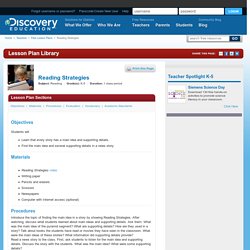
Find the main idea and several supporting details in a news story. Word work RF Longisland FCRR. Learning A-Z - Online Teaching Resources And Student Tools. Words Their Way. Phonemic Awareness. What is Phonemic Awareness? First of all, Phonemic awareness is not phonics.
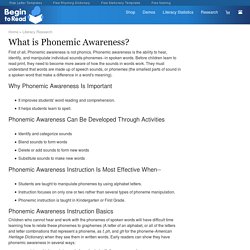
Phonemic awareness is the ability to hear, identify, and manipulate individual sounds-phonemes--in spoken words. Before children learn to read print, they need to become more aware of how the sounds in words work. They must understand that words are made up of speech sounds, or phonemes (the smallest parts of sound in a spoken word that make a difference in a word's meaning).
Phonemic Awareness - Pre Reading Skills - Reading Skills Pyramid - Time4Learning. Phonemic awareness is the understanding that words are made up of sounds which can be put together in different ways to make different words.
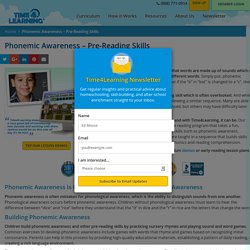
Simply put, phonemic awareness is the moment a child realizes that if the “b” in “bat” is changed to a “c”, then the word becomes “cat.” Phonemic awareness is a critical pre-reading skill which is often overlooked. And while each child is different, most learn to read following a similar sequence. Many are able to continue with no trouble when steps are missed, but others may have difficulty later because they didn’t make the connection. Learning to read should be an exciting time, and with Time4Learning, it can be. For more information, check out our curriculum demos or early reading lesson plans for kindergarten, first, and second grade. Research and Readinga-z.com - Phonological and Phonemic Awareness. Word Awareness Rhyme Awareness Onset and Rime Syllable Awareness Phonemic Awareness Word Awareness Word awareness is the knowledge that words have meaning.
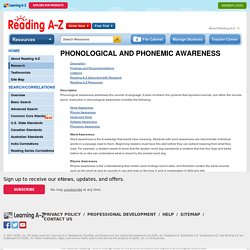
Students with word awareness can discriminate individual words in a passage read to them. Beginning readers must have this skill before they can extract meaning from what they read. For example, a student needs to know that the spoken word dog represents a creature that has four legs and barks before he or she can understand what is meant by the printed word dog. Phonemic Awareness Skill Games . PBS KIDS Raising Readers. Reading Comprehension Learning Tools - Time4Learning.
How Can Reading Comprehension be Taught?
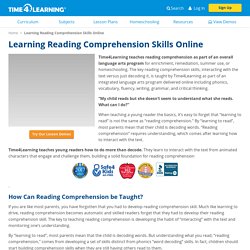
If you are like most parents, you have forgotten that you had to develop reading comprehension skill. Much like learning to drive, reading comprehension becomes automatic and skilled readers forget that they had to develop their reading comprehension skill. The key to teaching reading comprehension is developing the habit of “interacting” with the text and monitoring one’s understanding. By “learning to read”, most parents mean that the child is decoding words. But understanding what you read, “reading comprehension,” comes from developing a set of skills distinct from phonics “word decoding” skills. Free Reading Comprehension Worksheets - Printable. Free reading comprehension worksheets for grades 1-5 Use these free, printable worksheets to practice and improve reading comprehension, vocabulary and writing.
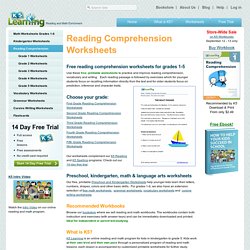
Each reading passage is followed by exercises which for younger students focus on recalling information directly from the text and for older students focus on prediction, inference and character traits. Choose your grade: Reading Comprehension Worksheets - Super Teacher Worksheets. Reading Comprehension « Reading Fluency, Nonsense Words and Fluency Practice. Fluency. Need More Practice for Fluency?

Raz-Kids provides hundreds of books for reading practice at school or home. Raz-Plus provides thousands of leveled books and other resources for reading practice. Students listen to books for modeled fluency. Reading Fluency. By: N.
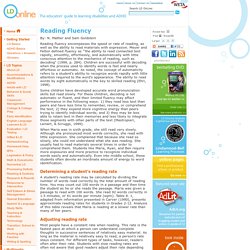
Mather and Sam Goldstein Reading fluency encompasses the speed or rate of reading, as well as the ability to read materials with expression. Meyer and Felton defined fluency as "'the ability to read connected text rapidly, smoothly, effortlessly, and automatically with little conscious attention to the mechanics of reading, such as decoding" (1999, p. 284). Children are successful with decoding when the process used to identify words is fast and nearly effortless or automatic. As noted, the concept of automaticity refers to a student's ability to recognize words rapidly with little attention required to the word's appearance. Some children have developed accurate word pronunciation skills but read slowly.
When Maria was in sixth grade, she still read very slowly. ELLs and Reading Fluency in English. Fluency is the ability to read words accurately and automatically with expression. Because fluent readers do not have to slow down in order to concentrate on decoding the individual words in a text, they can focus their attention on the text's meaning. In this way, fluency acts as a bridge between word recognition and comprehension, and this relationship is reciprocal. That is, when a student understands the meaning of the text he/she is reading, it is much easier to read that text with expression. Prosody is a term that is frequently heard in discussions of fluency. Developing Reading Fluency. Developing Reading Fluency Fluent reading is reading in which words are recognized automatically. With automatic word recognition, reading becomes faster, smoother, and more expressive, and students can begin to read silently, which is roughly twice as fast as oral reading. But beginning readers usually do not read fluently; reading is often a word-by-word struggle.
How do we help children struggling with slow, painstaking sounding out and blending? Support and encourage them. What's all the Nonsense about Teaching Nonsense Words? - Make Take & Teach. It’s been nearly 10 years now that our schools have been using the Dynamic Indicators of Early Literacy (DIBELS) Next as a school-wide reading assessment. DIBELS was first introduced as part of Reading First and fit so nicely into our new Response to Intervention initiative. The DIBELS Next is a valid and reliable screener that can identify students at-risk for reading difficulties. The idea is that if we can identify those students early, we can put in place interventions to actually prevent the reading problem! Personally, I love this assessment. It does exactly what it is suppose to do. Words ending in -tion, -sion, -cian. Not that many nouns have -sion endings.
They are often formed from verbs which end with -d, -de, -se, -t. Grade 3 and 4 Spellings: Words ending in -ion and -ian ('shun' sound) by katehatherell - US Teacher Lessons. Spelling and pronunciation - making sense of augh and ough. A well-known poem on the difficulties of English pronunciation starts: I take it you already know Of tough and bough and cough and dough. Others may stumble, but not you, On hiccough, thorough, though, and through And we might say that this applies just as much to spelling. Words with ough and augh are often cited as examples of our 'crazy' spelling system, and it's true that ough can have as many as seven or eight different sounds. But there aren't that many of these words, and they're quite easy to master.
Let's start with the easy one - augh: augh The letter group augh has two basic sounds: /ɑ:f/ (staff) laugh, laughable, laughter etc draught, draughty, draughtsman etc /ɔ:/ (horse) - everything else caught, taught daughter, naughty etc haugh (/ɔ:x/ in Scotland) - quite rare ough The letter group ough can come: e3l1l2shunsuffixes.